Lens Tutorial
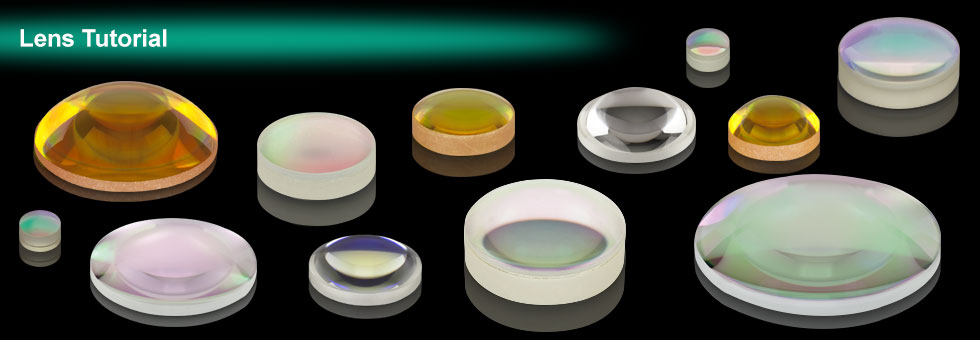

Please Wait
Lens Comparison
Thorlabs offers a wide variety of lenses with very different properties to match the needs of almost any application. However, it is important to choose lenses that are appropriate for a given system. As a general rule, spherical singlets are the most inexpensive, but they suffer from spherical aberration and other monochromatic aberrations. In addition, their single-element design means that they exhibit chromatic aberration that prevents optimum performance with broadband light. For correction of chromatic aberration, achromatic lenses are ideal. These multi-element optics also offer improved aberration correction for monochromatic light. For the best performance with monochromatic laser sources, aspheric optics are recommended. The surfaces of these lenses deviate from spherical sections, allowing for optimal aberration correction.
Table 1.1 gives an overview of the lenses offered by Thorlabs. More details can be found in the Spherical Singlets, Achromatic Lenses, Aspheric Lenses, and Lens Materials tabs on this page.
| Table 1.1 Lens Overview | ||||
|---|---|---|---|---|
| Lens | Focal Length | Conjugate Ratio | Chromatic Aberration Correction | Applications |
| Spherical Singlet Lenses | ||||
| Plano-Convex | Positive | 5X - Infinite | - | Focusing a Collimated Beam; Collimating a Point Source |
| Bi-Convex | Positive | 0.2X - 5X | - | Relay Imaging (Real Object and Image); Focusing a Divergent Beam |
| Plano-Concave | Negative | 5X - Infinite | - | Diverging a Collimated Beam; Collimating a Convergent Beam |
| Bi-Concave | Negative | 0.2X - 5X | - | Relay Imaging (Virtual Object and Image); Diverging a Convergent Beam |
| Best Form | Positive | Infinite | - | Focusing a Collimated Beam; Collimating a Point Source |
| Achromatic Lenses | ||||
| Cemented Achromatic Doublet | Positive | Infinite | Good | Broadband Focusing and Collimation; Improved Monochromatic Performance |
| Air-Spaced Doublet | Positive | Infinite | Better | Broadband Focusing and Collimation; Optimized On-Axis Performance; High-Power Applications |
| Cemented Doublet Pair | Positive | 1X - 3.33X | Good | Broadband Relay Imaging (Real Object and Image); Improved Monochromatic Performance |
| Cemented Achromatic Triplet | Positive | 1X - Infinite | Best | Broadband Focusing, Collimation, and Relay Imaging; Correction of All Primary Chromatic Aberrations |
| Aspheric Lenses | ||||
| Aspheric Lenses | Positive | Infinite | - | Optimized On-Axis Performance; Laser Diode Collimation; Fiber Coupling |
| Aspheric Lens Pairs | Positive | 1X - 3.66X | - | Optimized On-Axis Performance; Relay Imaging (Real Object and Image) |
| Aspheric Condensers | Positive | Infinite | - | Light Collection; Collimation of Incoherent Light |
Spherical Singlets
Spherical singlets are a good option for many situations where aberrations are not a great concern, as they are the simplest and most inexpensive type of lens to produce. For simple applications, standard plano-convex, plano-concave, bi-convex, and bi-concave lenses are sufficient. For better performance, best form lenses are optimized to reduce aberrations while still retaining spherical surfaces. The use of multiple lens elements within a compound optical system can lead to further performance improvements. Meniscus lenses are often employed in these multi-element optical systems, although they are rarely used alone. For the most demanding applications, spherical singlets will not perform as well as achromatic lenses (for both broadband and monochromatic sources) or aspheric lenses (for monochromatic sources). More details about these other types of lenses can be found on the Achromatic Lenses and Aspheric Lenses tabs.
Standard Singlets
Thorlabs offers several basic singlet designs: Plano-Convex, Bi-Convex, Plano-Concave, and Bi-Concave. Each of these lenses is suited for different applications. Plano-convex and bi-convex lenses are positive (i.e., they have a positive focal length) and will bring collimated light to a focus, while plano-concave and bi-concave lenses are negative and will cause collimated light to diverge. Each singlet lens shape minimizes aberrations for a certain conjugate ratio, defined as the ratio of the object distance to the image distance (these are called conjugate distances).
| Table 2.1 Positive Lenses | |
|---|---|
| Plano-Convex Lenses | Bi-Convex Lenses |
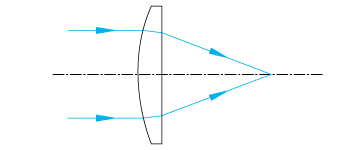 |
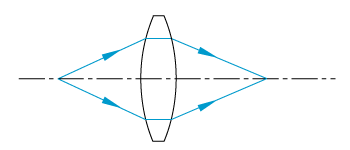 |
| Plano-convex lenses are best used where one conjugate distance is more than five times the other conjugate distance. The performance of this lens shape is best for an infinite conjugate ratio (focusing collimated light or collimating a point source). | Bi-convex lenses perform best when one conjugate distance is between 0.2 and 5 times the other conjugate distance. The performance of this lens shape is best when the object and image distances are the same. |
| Table 2.2 Negative Lenses | |
|---|---|
| Plano-Concave Lenses | Bi-Concave Lenses |
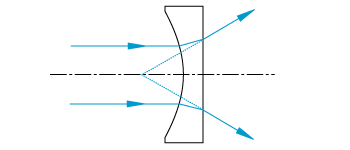 |
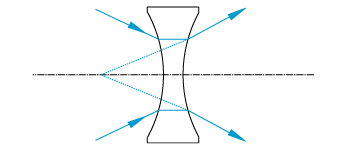 |
| Plano-concave lenses are best used when one conjugate distance is more than five times the other conjugate distance. They introduce negative spherical aberration and can be used to balance the positive spherical aberration introduced by positive focal length singlets. | Bi-concave lenses have a negative focal lengths and are commonly used to increase the divergence of converging light. |
Minimizing Aberrations
To minimize spherical aberration, a lens should be oriented so that the surface with the greatest curvature is facing the furthest conjugate point. For plano-convex and plano-concave lenses used at infinite conjugate ratios, this means that the curved surface should face the collimated beam (as shown in the drawings in Tables 2.1 and 2.2). The f-number of a lens, defined as the focal length divided by the aperture diameter, has a significant impact on the magnitude of image aberrations. Lenses with a small f-number ("fast" lenses) introduce significantly more aberrations than lenses with a large f-number ("slow" lenses). Lens shape becomes important for f-numbers below about f/10, and alternatives to spherical singlets (such as achromatic lenses and aspheric lenses) should be considered for f-numbers below about f/2.
Best Form Lenses
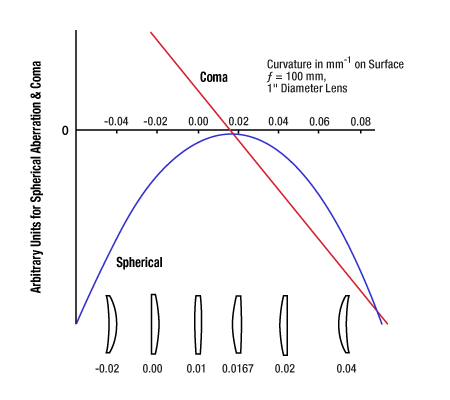
Figure 2.3 Spherical Aberration and Coma vs. Front Surface Curvature
Best form lenses are designed to minimize spherical aberration and coma (an aberration introduced for light not on the optical axis) while still using spherical surfaces to form the lens. The use of a spherical design makes best form lenses easier to manufacture than aspheric lenses (described on the Aspheric Lenses tab), reducing costs. Each side of a best form lens is polished so that it has a different radius of curvature, providing the best possible performance for a spherical singlet. For small input beam diameters, best form lenses are even capable of diffraction limited performance. These lenses are commonly used in high-power applications where cemented achromatic lenses are not an option (see the Achromatic Lenses tab for more information).
| Table 2.4 Best Form Lenses |
|---|
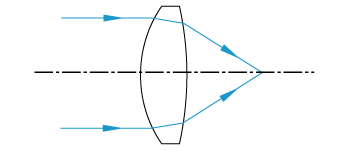 |
| Best form lenses are designed to minimize aberrations while still using spherical surfaces to form the lens. These lenses are optimized for an infinite conjugate ratio and are ideal for focusing collimated light or collimating a point source. |
Figure 2.3 shows a plot of coma and spherical aberration as a function of the curvature of the front face of a lens (the curvature is the inverse of the radius of curvature). The minimum spherical aberration nearly coincides with the zero coma point; the curvature where this minimum occurs is the basis for a “best form” design.
Meniscus Lenses and Multi-Element Lens Systems
Meniscus lenses are commonly used in multi-element optical systems to modify the focal length without introducing significant spherical aberration. The optical performance of multi-element lens systems is often significantly better than the performance of single lenses. In these systems, aberrations introduced by one element can be corrected by subsequent optics. These lenses have one convex and one concave surface, and they can be either positive or negative.
| Table 2.5 Meniscus Lenses | |
|---|---|
| Positive Meniscus Lenses | Negative Meniscus Lenses |
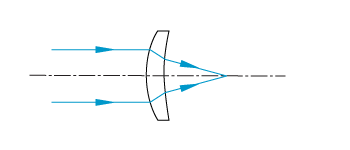 |
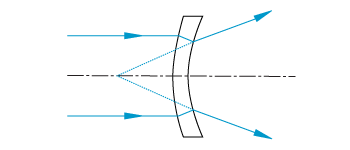 |
| Positive meniscus lenses are typically used in cominbation with another lens in a compound optical assembly. When used in this configuration, a positive meniscus lens will shorten the focal length and increase the numerical aperture (NA) of the system without introducing significant spherical aberration. | Negative meniscus lenses are typically used in combination with another lens in a compound optical assembly. When used in this configuration, a negative meniscus lens will increase the focal length and decrease the numerical aperture (NA) of the system. |
Figure 2.6 shows the performance gains that can be achieved by using multi-element lens systems. A single element plano-convex lens with a focal length of 100 mm produces a spot size of 240 µm [Figure 2.6 (a)]. In addition, the single lens introduces 2.2 mm of spherical aberration, defined as the distance betwen the marginal focus (where rays on the very edge of the lens focus) and the paraxial focus (where rays in the center of the lens focus). By combining two plano-convex lenses with focal lengths of 100 mm, for an effective focal length of 50 mm, the focused spot size is decreased to 81 µm and the spherical aberration is reduced to 0.8 mm [Figure 2.6 (b)]. An even better option, however, is to combine the f=100 mm plano-convex lens with a positive f=100 mm meniscus lens. Figure 2.6 (c) shows the results: the focused spot size is reduced to 21 µm and the spherical aberration is reduced to 0.3 mm. Note that the convex surfaces of both lenses should be facing away from the image point.
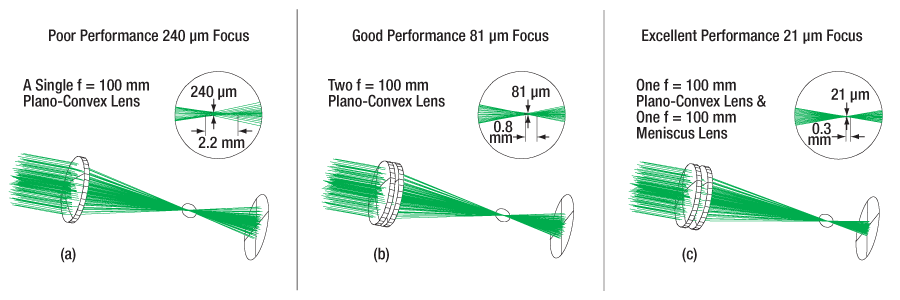
Figure 2.6 Improved Performance of Multi-Element Systems
Achromatic Lenses
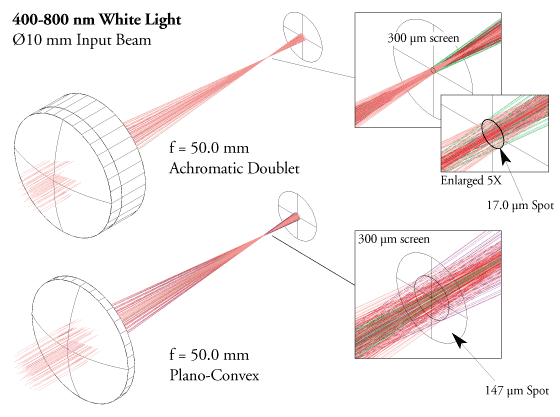
Figure 3.1 Focusing White Light with a Plano-Convex and an Achromatic Doublet Lens
Achromatic lenses, or achromats, consist of two or three lens elements and offer significantly better performance than simple singlet lenses. The lenses in an achromatic doublet or triplet are either cemented together or have an air gap between them and typically include both positive and negative elements with different indices of refraction. This multi-element design offers a number of advantages, including reduced chromatic aberration, improved imaging of monochromatic light, and improved off-axis performance. The different kinds of achromatic lenses and their properties, such as conjugate ratio and damage threshold, are described at the bottom of this page. For any application with demanding imaging or laser beam manipulation needs, these achromats should be considered.
Reduced Chromatic Aberration
Since the index of refraction of a material depends upon the incident wavelength, the focal length of a single lens depends on the incident wavelength. This leads to a blurred focal spot when singlet lenses are used with a white light source. This phenomenon is known as chromatic aberration. An achromatic lens can partially compensate for chromatic aberration by virtue of its multi-element design.
The constituent optical elements of an achromatic lens generally include both positive and negative lenses with different amounts of dispersion. If the material dispersion values and focal lengths of these constituent lenses are chosen carefully, a partial cancellation of the chromatic aberration can be achieved. Typically, achromatic lenses are designed to have the same focal length for two wavelengths at opposite ends of the visible spectrum. This results in a nearly constant focal length across a wide range of wavelengths.
The use of achromats is beneficial for any broadband imaging application that utilizes a large wavelength range. Figure 3.1 shows the effect on focal length for a number of different wavelengths incident on both a plano-convex singlet and achromatic doublet. The diameter of the focal spot is reduced from 147 µm to 17 µm by replacing the singlet with the achromatic doublet.
Improved Imaging for Monochromatic Light
When an optical system is used with monochromatic light, the chromatic aberration discussed above is inconsequential. However, spherical singlets can still introduce significant monochromatic aberrations, such as spherical aberration and coma. The multi-element design of achromatic lenses reduces these aberrations and leads to significantly increased image quality and tighter focusing of monochromatic light. For example, Figure 3.2 compares the performance of a plano-convex lens and an achromatic doublet in focusing a monochromatic beam. As can be seen, the diameter of the focal spot produced by the doublet is 4.2 times smaller than that produced by the singlet.
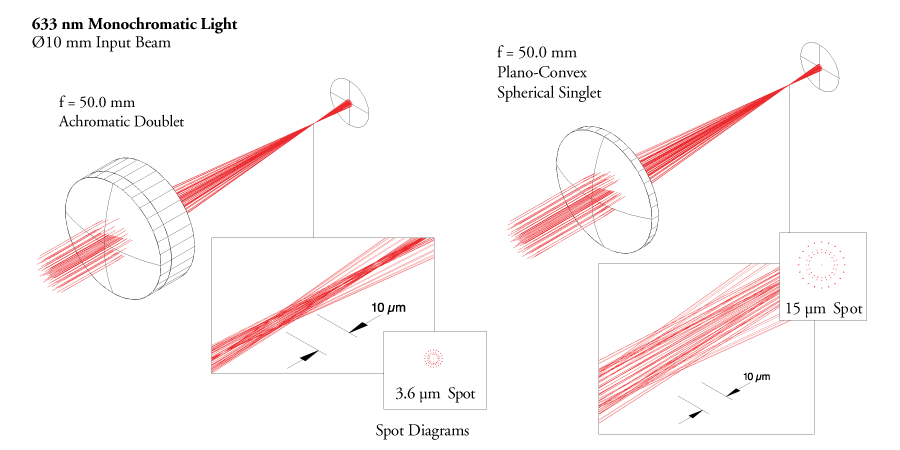
Figure 3.2 Focusing a Monochromatic Beam with Both a Plano-Convex and Achromatic Doublet Lens
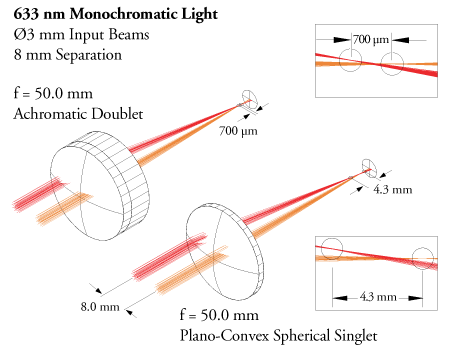
Figure 3.3 Off-Axis Performance for a Plano-Convex and an Achromatic Doublet Lens
Superior Off-Axis Performance
For spherical singlets, the effect of off-axis aberrations can significantly compromise the performance of the lens if the beam is not propagating through the exact center of the lens. Achromatic lenses are less sensitive to centration, meaning that off-lens-axis beams are focused to almost the same spot as on-axis beams. Generally, achromatic triplets are even better than doublets at correcting for these off-axis effects.
Figure 3.3 shows two Ø25 mm, f=50.0 mm lenses, one of which is a plano-convex spherical singlet and the other is an achromatic doublet. Each lens has one beam propagating along the optical axis and another propagating parallel to the axis but offset by 8 mm. The achromatic doublet reduces both lateral and transverse aberrations; the lateral displacement of the focal points (circled in the diagram) is reduced by a factor of six and the focal spot diameter is also significantly smaller.
Selecting an Achromatic Lens
Achromatic lenses are a good choice for any demanding optical application, as they offer substantially better performance than spherical singlets. Cemented achromatic doublets are sufficient for most applications at infinite conjugates, and cemented doublet pairs are ideal for finite conjugates. However, the cement used in these optics reduces their damage threshold and limits their usability in high-power systems. Air-spaced doublets are ideal for high-power applications, as they have a greater damage threshold than cemented achromats. In addition, air-spaced doublets have two more design variables than cemented doublets because the interior lens surfaces do not need to have the same curvature. These extra variables allow the performance of air-spaced doublets to far exceed the performance of cemented doublets in terms of transmitted wavefront error, spot size, and aberrations. However, air-spaced doublets are also more expensive than cemented doublets.
Achromatic triplets can be designed for both finite (Steinheil Triplet) and infinite (Hastings Triplet) conjugate ratios. These triplets consist of a low-index center element cemented between two identical high-index outer elements. They are capable of correcting both axial and laterial chromatic aberration, and their symmetric design provides enhanced performance relative to cemented doublets.
| Table 3.4 Achromatic Lenses | |
|---|---|
| Cemented Doublets | Air-Spaced Doublets |
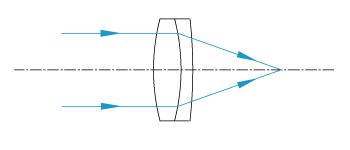 |
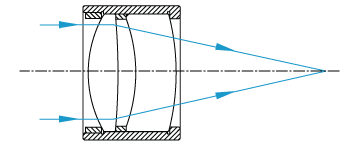 |
| Achromatic doublets offer several advantages over simple singlet lenses. These include a minimization of chromatic aberration, improved off-axis performance, and smaller focal spots. These doublets have positive focal lengths and are optimized for an infinite conjugate ratio. | Air-spaced doublets offer even better performance than cemented doublets, as they are optimized with respect to the lens separation. These optics are ideal for high power applications, as they offer a greater damage threshold than cemented doublets. These doublets have positive focal lengths and are optimized for an infinite conjugate ratio. |
| Doublet Pairs | Achromatic Triplets |
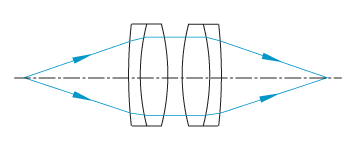 |
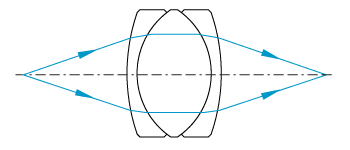 |
| Achromatic doublet pairs offer the advantages of achromatic lenses, while being optimized for finite conjugates. These pairs are ideal for image relay and magnification systems. | Achromatic triplets offer even better performance than achromatic doublets. An achromatic triplet is the simplest lens that corrects all primary chromatic aberrations. Steinheil Triplets are optimized for finite conjugate ratios, while Hastings Triplets are optimized for infinite conjugate ratios. |
Aspheric Lenses
Aspheric lenses offer optimized on-axis performance at an infinite conjugate ratio, an advantage over spherical singlets and achromatic doublets. While individual spherical lenses can refract light at only small angles before spherical aberration is introduced, aspheric lenses are designed with curved surfaces that deviate from a sphere. This deviation is designed to eliminate spherical aberrations when light is refracted at large angles. As such, aspheric lenses are ideal for applications like laser diode collimation and fiber coupling that require a small f-number and large numerical aperture (NA). However, aspheric lenses are made from a single material and suffer from chromatic aberration. As such, they are typically used for monochromatic applications.
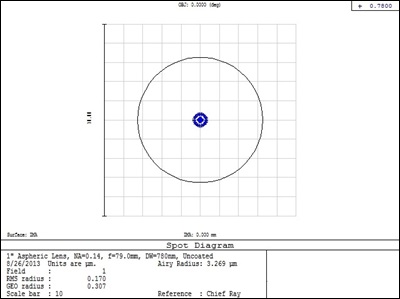
Figure 4.1 Theoretical Diffraction-Limited Spot Size
Theoretical Diffraction-Limited Performance
Figure 4.1 shows ray tracing results for a 780 nm beam at the image plane of an ASL10142 lens (f = 79.0 mm at 780 nm). The Airy disk has a diameter of 6.538 µm, and is depicted by a black circle. Since all the rays (in blue) are well within the diameter, the theoretical spot size is diffraction limited.
Aspheric lenses have several particularly important applications, including laser diode collimation, fiber coupling, and light collection.
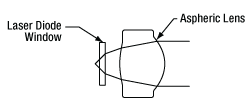
Figure 4.2 Collimating a Laser Diode Output with an Aspheric Lens
Collimating Laser Diodes
In laser diode systems, difficulties with aberration correction are compounded by the beam’s high divergence angle. Because of spherical aberration, three or four spherical singlet elements are often required to collimate the light from a laser diode. A single aspheric lens can collimate the highly divergent emission of a laser diode without introducing spherical aberration, as shown in Figure 4.2. Again, the flatter side of the optic should face the source for optimum performance.
When choosing an aspheric lens for collimation of a laser diode, the first step is to determine the numerical aperture of the diode. This value is given by the sine of the largest FWHM divergence angle of the laser light. Then, an aspheric lens should be chosen that has roughly twice the numerical aperture of the laser. This will ensure that the aspheric lens collects as much light as possible (much of which is outside the FWHM divergence angle).
Fiber Coupling
When coupling light into a fiber, it is often necessary to focus a collimated beam of light to a diffraction-limited spot. Typically, single spherical elements and achromatic doublets are not capable of achieving such a small spot size; spherical aberration is the limiting factor rather than diffraction. Since aspheric lenses are designed to eliminate spherical aberration, only diffraction limits the size of the focal spot.
When choosing an aspheric lens for coupling light into a single mode fiber, the diffraction-limited spot size should be matched to the mode field diameter (MFD) of the fiber. The required focal length for the lens can easily be calculated from the MFD and the beam diameter. If an aspheric lens is not available that provides an exact match, then choose the aspheric lens with a focal length that is shorter than the calculation yields. Alternatively, if the clear aperture of the aspheric lens is large enough, the beam can be expanded before the aspheric lens, which has the result of reducing the spot size of the focused beam.
Light Collection
Many applications, such as microscopy, make use incoherent lamps and high-power LEDs as illumination sources. These applications benefit from the efficient collection of as much light as possible, suggesting the use of a large aperture lens to collimate the output of the source. Unfortunately, large aperture lenses tend to introduce more aberration than smaller lenses, reducing the quality of the resulting collimated light. Aspheric condenser lenses are ideal for efficient light collection, as they offer large diameters and numerical apertures as well as the reduced spherical aberration of an aspheric design.
| Table 4.3 Aspheric Lenses | |
|---|---|
| Aspheric Lenses | Aspheric Collimators |
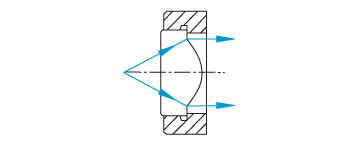 |
 |
| Aspheric lenses focus or collimate light without introducing spherical aberration into the transmitted wavefront. Molded aspheric lenses are economical and available in both glass and plastic. For better performance, precision polished aspheric lenses introduce substantially less wavefront error and are offered with larger diameters. | Aspheric collimators are designed to collimate divergent light with diffraction-limited performance. We offer fixed focus and adjustable focus fiber collimators as well as laser diode collimation tubes. |
| Aspheric Lens Pairs | Aspheric Condensers |
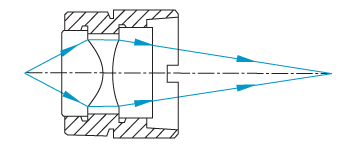 |
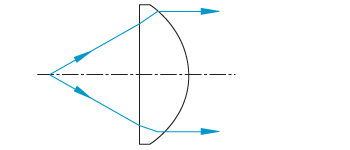 |
| Aspheric lens pairs are designed for near aberration-free finite conjugate imaging. These pairs are ideal for image relay and magnification systems. | Aspheric condensers are designed for high-efficiency illumination applications. They offer reduced spherical aberration with large apertures and low f-numbers. They are ideal for collimating light from a lamp or LED. |
Lens Materials
Thorlabs' wide breadth of optics manufacturing capabilities allows us to offer lenses made from a variety of optical materials. Table 5.1 should aid with the selection of a lens best suited for use at a particular wavelength. To view transmission plots for the uncoated materials, please click on the appropriate icon below. For more details on optical substrates, please see our Optical Substrates tutorial.
| Posted Comments: | |
gianlluca santagati
(posted 2024-07-05 07:22:13.59) Hello, i would like to focus a laser beam HNLS008R. Can I use an achrimatic lens to reduc the beam spot?
Caould you suggest a lens to focus at 30 cm from the lens and achieve a beam profile very small (50 micron or less)?
Thanks on advance ksosnowski
(posted 2024-07-09 05:04:26.0) Hello Gianlluca, thanks for reaching out to us. For a smaller spot size typically a shorter focal length lens and a larger input beam diameter are advantageous to achieving a better diffraction limited spot size. With the HNLS008R's beam size it may help to use a beam expander to allow for your longer working distance of 30cm. I have reached out directly to discuss this application in further detail. nilesh singnurkar
(posted 2022-11-11 18:07:44.327) I am in the need of a hard copy of detailed catalogue
Address:
F 603
goodwill garden
Plot no 15 16
sector 8 kharghar 410210
district Raigad
state Maharashtra
India cdolbashian
(posted 2022-11-16 11:52:09.0) Unfortunately, we stopped producing hard copies of our catalogue several years ago. Hernando Avila
(posted 2019-09-16 18:01:09.713) Hello: I need lens to calibrate lensmeter, are you have lens certified for calibartion?
Thanks YLohia
(posted 2019-09-17 11:07:02.0) Hello, thank you for contacting Thorlabs. I have reached out to you directly to discuss the possibility of offering such a lens. rogergohl
(posted 2017-12-05 09:52:22.677) Dearvthorlabs I am looking for lenses reasonably priced to make a home made project telescope that might compete with something. Store botten. tfrisch
(posted 2017-12-05 01:42:02.0) Hello, thank you for contacting Thorlabs. Our components have been used in telescopes. I will reach out to you to discuss what it is you would like to view and what specifications that would require. itriA20034
(posted 2017-02-07 10:15:25.953) Dear thorlabs,
we need a lens made from a birefringent material(Applied optics vol.39 pp.592-598, 2000). Do you provide the related products? tfrisch
(posted 2017-02-15 01:08:16.0) Hello, thank you for contacting Thorlabs. Unfortunately, we do not offer birefringent lenses at this time. I will reach out to you directly as well. swift.yan
(posted 2015-10-08 14:59:34.883) I found an error in the Lens Materials tab. The transmission range for Ge should be 2 - 16 um, not 2.0 - 2.6 um. besembeson
(posted 2015-10-08 04:52:36.0) Response from Bweh at Thorlabs USA: That is correct and thanks for pointing that out. We will fix that. |
 Products Home
Products Home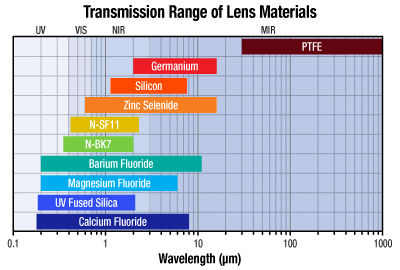
 Lens Tutorial
Lens Tutorial